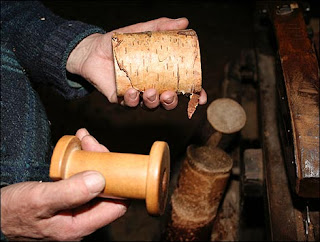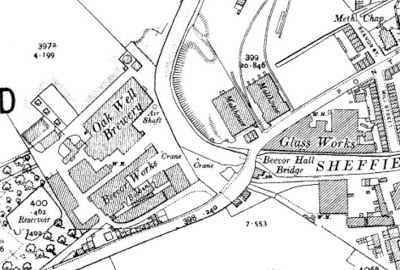I found this explanation online in an article about women's work in South Yorkshire, "Bobbins are the core onto which thread is wound so that it can be woven into cloth. Many women worked in bobbin production at Beever Mill, Barnsley, which had a mixed workforce of 6-700. Women worked the machines shaping the bobbins and in the glue and press shop where metal ends were fitted to the bobbins."
 |
| From wood to bobbin (from the BBC) |
 |
| Steel banded bobbin (from Harbour Farm.com) |
The completed bobbins, with metal capping at both ends are now apparently desirable articles for "candlesticks and silk flower holders". The picture of the left is from an American website, the bobbin was selling for $14.50.
Barnsley has been home to many other industries besides the coal mines that everyone associates with the area.
 |
| 1906 map snip of the Beevor area of Barnsley (from Old Maps) |
 |
| 1852 map snip of the Beever Hall Bleachworks (from Old Maps) |
Barnsley once had a thriving linen weaving industry and bobbins would have been used in that. Beever (or possibly Beevor) Mill is long gone, along with all the textile mills in Barnsley, if you follow the link there is a map of their locations and you can click to find out more details.
I started this post intending to write about an ancestor who made bobbins, but got side tracked. It doesn't matter, it was interesting anyway. I am now wondering what happened to all of Barnsley's thousands of bobbins though, if they are worth over £9 each to the Americans!

4 comments:
Hi a very interesting article I was doing a bit of exploring in hoyle mill last week to see how much has change since my youth ie the 1960 s quite a lot is appears. I noticed beevor hall is long gone which set me wondering who they were and what the family did especially as my first train set came from beevor hall a second hand purchase so I assume a family lived there
Hi Andy, I noticed you commented twice. Comments all go to moderation so are dependent on me checking my emails. I have published the first one only as they were mostly the same, bat a comment about Miss Beevor. Thanks for reading, that is a very good question about the family and maybe when the Barnsley Archives are up and running again they might have that information for you.
Thanks again,
Linda
aka BarnsleyHistorian
My Grandmother, Mrs Northrop lived in No 10 Beevor Street, opposite the Chapel. We all loved the house and remember watching the glass blowers at night and hearing the sounds of tools dropping to the floor. At the front of the house, across the road was an area where they would throw rejects, which we would pick up and keep. So many happy memories of Hoyle Mill, especially Friday night fish and chips. I remember hearing the factory siren from the glass works and many a happy hour spent walking in the fields. Hoyle Mill was thriving in the early sixties. And my mother, Grandmother had their own wonderful memories. My mother Mary Northrop (nee Gascoyne) was the first girl from Hoyle Mill to go to the High School. A few of my uncles worked down the mines. My grandfather who I sadly never met was killed as he was repairing a floor at Woods Glass factory.
Thank you for this. Such memories, thank you for sharing them.
Linda
(BarnsleyHistorian)
Post a Comment